It’s already time for another science blog. Sticking with the theme of ecosystem context, data analyst Ellie K gives you the lowdown on Antarctic krill
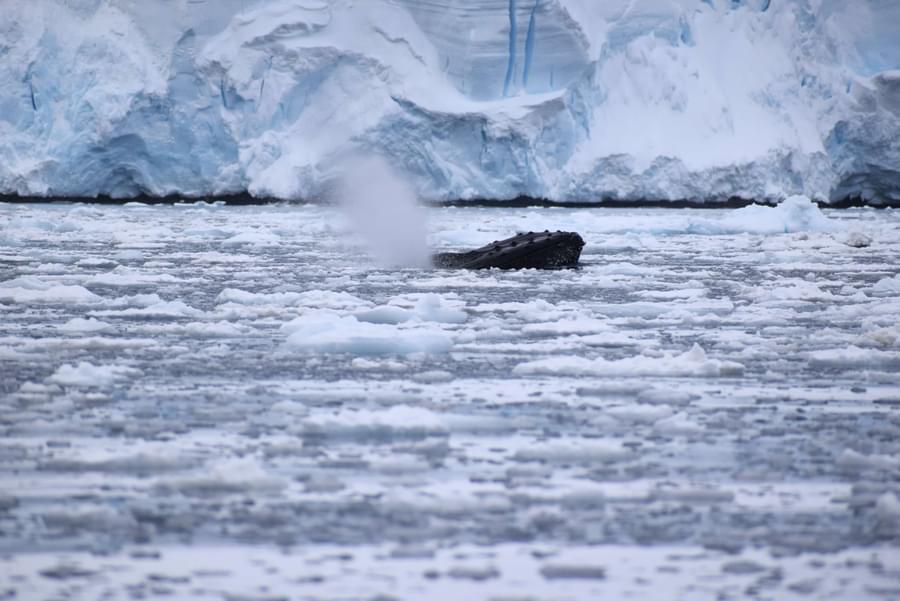
It’s already come to the end of this 2023/24 Antarctic summer season and we have continued to record lots and lots of whales down there in the Southern Ocean. Why is Antarctica such a prime destination for whales though? The short answer is krill. If that’s all you wanted to know then thanks for reading, don’t forget to donate! Otherwise, get comfy and keep reading. Those of you who have had a brush with ecology before might be familiar with the concept of a keystone species. These are species that play a disproportionate role in the structure and function of ecosystems (2). Some famous examples you might have heard of include wolves in Yellowstone Park, starfish in the intertidal zones of the Pacific coast of North America and sea otters in kelp forests. Antarctic krill is such a species.
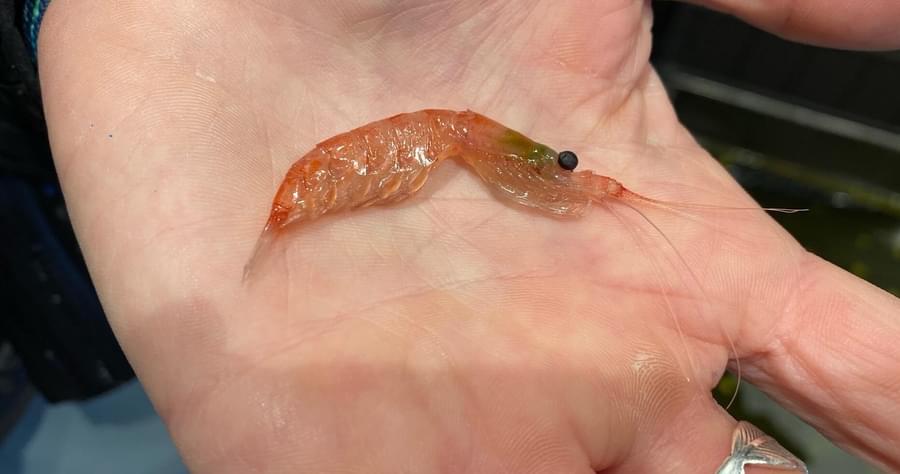
What IS krill?
Krill is kind of like a small shrimp. In Antarctica, the dominant species is (you guessed it) the Antarctic krill (Euphausia superba) and although there are other less famous species in Antarctica and indeed around the world, I will refer to them all as krill from here onwards. If you’ve seen a few nature documentaries, you may have heard something along the lines of ‘krill are one of the smallest animals but they support the largest animals on earth (i.e. whales)’. In fact, krill are pretty chunky compared to other whale prey. For example, take a key player in the food webs of the colder parts of the North Atlantic; Calanus finmarchichus (a species of copepod, too cool for a common name) which comes in at 4 millimetres long at most. A fully grown krill is about 15 times larger at a hefty 6 centimetres long. Being quite large, they occupy a grey area between big zooplankton (weakly swimming and unable to do much to counter the ocean currents) and small nektonic animals (i.e. able to go where they like despite the currents).
Krill and the food chain
There is lots of krill; in the region of hundreds of millions of tonnes, although the actual amount can fluctuate dramatically between years and is difficult to pin down exactly due to the patchy distribution of krill as well as inefficiencies in sampling and different methods used over time (3). Since they can eat phytoplankton directly, specifically diatoms which are pretty large as far as phytoplankton go, they are key in the Southern Ocean food web (4). Most of the iconic Antarctic species from penguins to whales depend on krill as prey in one way or another (4). Besides their huge abundance, there are a few other reasons for the importance of krill to these charismatic species. For one thing, krill are susceptible to crowd psychology and will often form dense swarms which at their extreme can reach kilometres long and hundreds of metres thick (5). This is possibly because of safety in numbers or because finding food and mates is easier when they stick together. Regardless of the motivation for swarming, this behaviour is really convenient if you happen to be a massive whale who needs prey patches of a certain density to feed at a profit, hence the importance of krill in the diets of large whales (6). Other species can also benefit from high concentrations of prey as it means they can spend less time searching and more time eating, leaving more energy for other stuff such as rest and reproduction.
As a consequence of their centrality in the food chain, the success of krill predator populations hinges on the success of krill themselves. Land based predators such as penguins, other seabirds and seals are more accessible to researchers, so much of the work on this has been carried out on this group. In general, declines in krill equate to declines in breeding success for these species, with species that are less capable of switching to other sources of food in a bad krill year more severely impacted (7). Although trickier to study, it follows that whales are also affected by booms and busts in krill populations and indeed, changes in the number of southern right whale calves (8) and humpback whale pregnancy rates (18) have been related to changes in krill abundance.
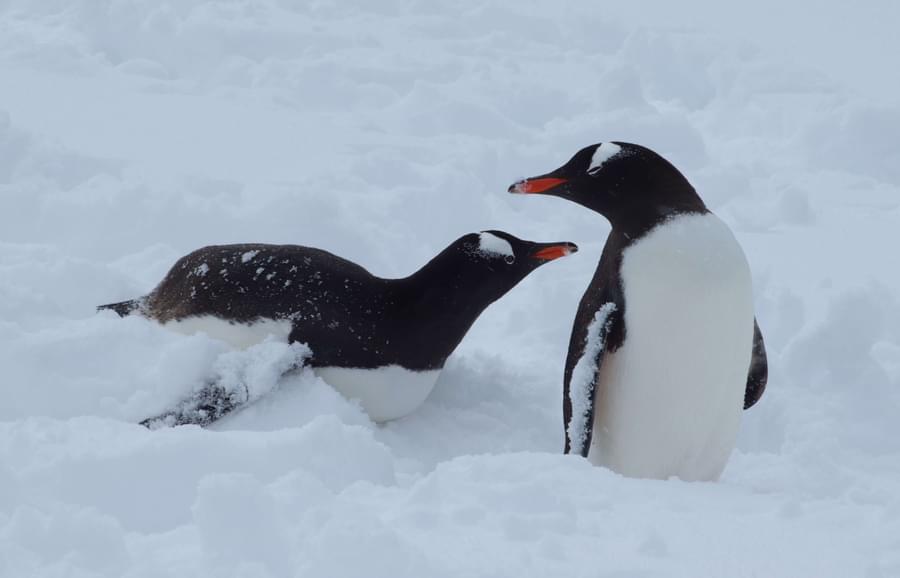
Krill and climate change
Beyond acting as whale food, krill provide services for you as well. I mentioned earlier that krill help to transfer primary production up the food chain by feeding at the very bottom of it, i.e. on primary producers. Those of you who remember your biology/biochemistry may recall that a key ingredient for successful photosynthesis is carbon dioxide, the very same carbon dioxide that is trapping all the heat in and making it uncomfortably warm here on earth. By using up some CO2 to grow, phytoplankton can trap a little bit of it in their tissues and take it with them to the deep ocean when they die and become seafloor sludge, assuming they get that far without getting eaten by various scavengers along the way. Krill can help to accelerate this process by eating lots of phytoplankton and repackaging them into denser poo pellets that sink faster than an individual phytoplankton cell that died of other causes might, increasing the chance of getting that carbon out of the atmosphere and into the deep sea sediments where it won’t bother us for another few million years (9).
They also spend some time at depths themselves and have been observed at the very bottom of the deep ocean (10). While they’re down there, they will be respiring as normal which traps even more of the CO2 (remember, a byproduct of respiration) in the deep ocean (9). But wait, there’s more. Nutrient levels are high overall in Antarctica, but iron, a small but key component of phytoplankton biochemistry, can be scarce which limits the amount of photosynthesis and by extension the amount of carbon fixation can take place. This makes it a high nutrient low chlorophyll area. Fortunately, krill themselves are rich in iron and can supply extra iron to the photic zone through their various excretions where phytoplankton can use it to trap more carbon (9). As major krill predators, whales and their faeces also concentrate iron and boost primary productivity (11).
Despite all their biomass, krill can’t completely balance out rising emissions and the resulting rising temperatures could be bad news for krill. One of the most striking impacts of climate change is a reduction in ice at the poles. I’m sure I don’t need to tell you that ice will melt if it isn’t kept cool and most of the warming and resulting sea ice loss has taken place in the Atlantic sector where the bulk of krill are found (13). Besides permanent loss of sea ice, the sea ice season in this region of Antarctica has shortened: in one area of the Antarctic Peninsula the season shortened by 92 days per year on average between the end of the 1970s and the early 2010s (12). Loss of sea ice is loss of habitat for species that depend on it for foraging and other important parts of their life cycle. We are all heartbroken by images of emaciated polar bears and catastrophic declines in the pups of ice-associated seal species, but krill are also suffering. Their abundance is linked with sea ice extent with more krill observed in summers following icier winters (14). This is because baby krill, more properly known as larvae, have a limited capacity to store the abundant food available in the summer and autumn and are therefore more reliant on algae that inhabits the bottom of sea ice during the winter months lest they starve. Less sea ice available for shorter periods is therefore predicted to hit the survival of baby krill into adulthood and ultimately to negatively impact krill abundance as things heat up (13).
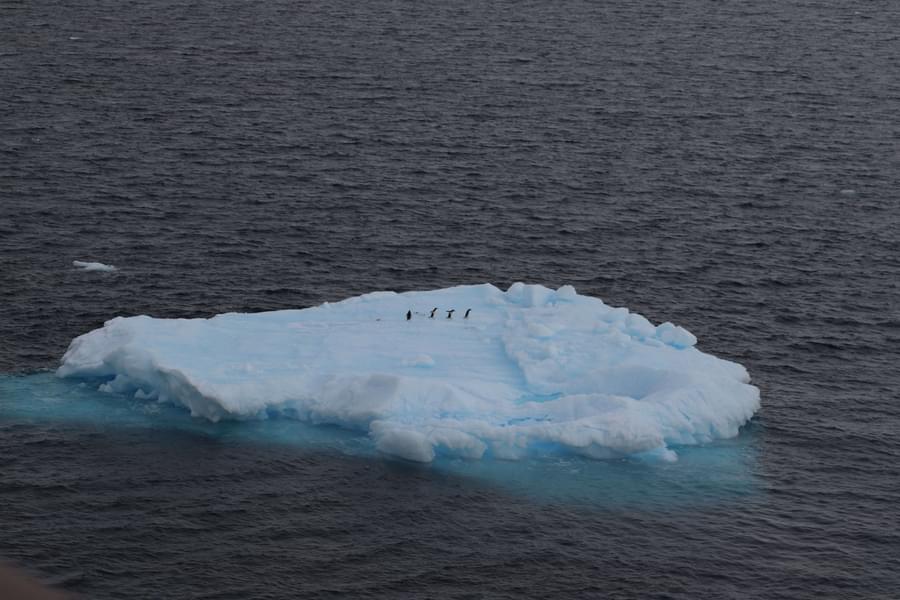
Krill and fisheries
Since there is so much krill, we thought it was a shame not to make a profit from it and after a few years of exploratory fishing, commercial fisheries for krill began in the 1970s. You may wonder: how can a fishery for a small species be profitable? Well, krill oil is sold as a source of omega 3 for people for one thing and krill is used as aquaculture feed for another thing. Less commonly, krill is also sold as food for humans, although it takes a lot of processing to make them edible (15). Krill fisheries are currently managed using an ecosystem approach where catch limits are set as a tiny fraction of the total biomass estimates so that there will be enough for everything else that actually needs to eat it, plus enough krill left over to replenish the stock (15). For the Atlantic sector, the quota is set at 5.6 million tonnes by the Commission for the Conservation of Antarctic Living Resources (CCAMLR) (16). This represents only around 10% of the estimated krill biomass of 56 million tonnes in 2000 that the quota is based on. Further still, only 620,000 tonnes of this amount can be caught before additional management action is triggered (16). Actual landings of krill are an even smaller fraction of this amount, for example in 2022 the reported catch was 415,508 tonnes (16).
On the surface then, it might seem like there is scope to fish more krill, no? Well, not exactly. If you were paying attention, you might have noticed that I said most krill are concentrated in the Atlantic sector of the Southern Ocean and since that’s where they all are, that’s where most of the fishing takes place. This is also where many penguin and seal colonies are located and in recent years, fishing activity has become even more concentrated in hotspots that seem to overlap with predator habitats (19). Unsurprisingly, there are concerns that this could intensify the competition between fisheries and other krill predators who need it to live and some evidence suggests that even this seemingly low level of fishing can have an impact on the predators of krill (20). And as we aren’t sure exactly to what extent climate change is going to hit krill abundance in the future (13,17), there is the potential for fishing and climate change to act in synergy and compound krill declines with possible consequences for their predators, including recovering whale populations (18) so perhaps krill is not as underexploited as it may seem just by looking at the numbers and not taking into account the rest of the ecosystem.
Krill and the future
Like most things, the reality is much more nuanced than the above. I encourage you to look into the complexities yourself if this kind of thing interests you, which it should because it’s cool! In summary, climate change could spell trouble for krill and by extension, its predators but there is still lots of uncertainty about how exactly things will play out. It might not be a good idea to fan the flames of possible krill declines by expanding krill fisheries further in the meantime. Monitoring krill predators including whales could also give us an idea of how things are going for krill, hence the importance of ORCA’s work in the Southern Ocean.
References
(1) Savoca, M.S., Czapanskiy, M.F., Kahane-Rpport, S.R., Gough, W.T., Fahlbusch, J.A., Bierlich, K.C., Segre, P.A., Di Clemente, J., Penry, G.S., Wiley, D.N., Clambokidis, J., Nowacek, D.P., Johnston, D.W., Pyenson, N.D., Friedlaender, A.S., Hazen, E.L. and Goldbogen, J.A. (2021). Baleen whale prey consumption based on high-resolution foraging measurements. Nature 599: 85-90
(2) Cottee-Jones, H.E.W. and Whittaker, R.J. (2012). The keystone species concept: a critical appraisal. Frontiers of Biogeography 4(3): 117-127
(3) Atkinson, A., Siegel, V., Pakhomov, E.A., Jessopp, M.J. and Loeb, V. (2009). A re-appraisal of the total biomass and annual production of Antarctic krill. Deep-Sea Research I 56: 727-740
(4) Murphy, E.J., Hofmann, E.E., Watkins, J.L., Johnston, N.M., Pinones, A., Ballerini, T., Hill, S.L., Trathan, P.N., Tarling, G.A., Cavanagh, R.A.,Young, E.F., Thorpe, S.E., Fretwell, P. (2013). Comparison of the structure and function of Southern Ocean regional ecosystems: the Antarctic Peninsula and South Georgia. Journal of Marine Systems 109-110: 22-42
(5) Tarling, G.A. and Fielding, S. (2016). Swarming behaviour in Antarctic krill. In: Volker, S. ed. Biology and Ecology of Antarctic Krill. Springer
(6) Trathan, P.N. and Hill, S.L. (2016). The importance of krill predation in the Southern Ocean. In: Volker, S. ed. Biology and Ecology of Antarctic Krill. Springer
(7) Croxall, J.P., Reid, K. and Prince, P.A. (1999). Diet, provisioning and productivity responses of marine predators to difference in availability of Antarctic krill. Marine Ecology Progress Series 177: 115-131
(8) Seyboth, E., Groch, K.R., Dalla Rosa, L., Reid, K., Flores, P.A.C. and Secchi, E.R. (2016). Southern right whale (Eubalaena australis) reproductive success is influenced by krill (Euphausia superba) density and climate. Scientific Reports 6: 28205
(9) Cavan, E.L., Belcher, A., Atkinson, A., Hill, S.L., Kawaguchi, S., McCormack, S., Meyer, B., Nicol, S., Ratnarajah, L, Schmidt, K., Steinberg, D.K., Tarling, G.A. and Boyd, P.W. (2019). The importance of Antarctic krill in biogeochemical cycles. Nature Communications 10: 4742
(10) Clarke, A. and Tyler, P.A. (2008). Adult Antarctic krill feeding at abyssal depths. Current Biology 18: 282-285
(11) Nicol, S., Bowie, A., Jarman, S., Lannuzel, D., Meiners, K.M. and van der Merwe, P. (2012). Southern Ocean iron fertilisation by baleen whales and Antarctic krill. Fish and Fisheries 11(2): 203-209
(12) Ducklow, H.W., Fraser, W.R., Meredith, M.P., Stammerjohn, S.E., Doney, S.C., Martinson, D.C., Sailley, S.E., Schofield, O.M., Steinberg, D.K., Venables, H.J. and Amser, C.D. (2013). West Antarctic Peninsula: an ice-dependent coastal marine ecosystem in transition. Oceanography 26(3):
(13) Flores, H., Atkinson, A., Kawaguchi, S., Krafft, B.A., Milinevsky, G., Nicol, S., Reiss, C., Tarling, G.A., Werner, R.,Bravo-Rebolledo,, E., Cirelli, V., Cuzin-Roudy, J., Fielding, S., Groeneveld, J.J., Haraldsson, M., Lombana, A., Marschoff, E., Meyer, B., Pakhomov, E.A., Rombola, E., Schmidt, K., Siegel, V., Teschke, M., Tonkes, H., Toullec, J.Y., Trathan, PN., Tremblay, N., Van de Putte, A.P., van Franeker, J.A. aand Werner, T. (2012). Impact of climate change on Antarctic krill. Marine Ecology Progress Series 458:1-19
(14) Atkinson, A., Siegel, V., Pakhomov, E. and Rothery, P. (2004). Long-term decline in krill stock and increase in salps within the Southern Ocean. Nature 432: 100-103
(15) Nicol, S. and Foster, J. (2016). The fishery for Antarctic krill: its current status and management regime. In: Volker, S. ed. Biology and Ecology of Antarctic Krill. Springer
(16) CCAMLR Secretariat (2023). Fishery report 2022: Euphausia superba in Area 48. Accessed on 24/04/2024. Available at: https://fishdocs.ccamlr.org/Fi...
(17) McBride, M.M., Schram Stokke, O., Renner, A.H.H., Krafft, B.A., Bergstad, O.A., Biuw, M., Lowther, A.D. and Stainsen, J.E. (2021). Antarctic krill Euphausida superba: spatial distribution, abundance and management of fisheries in a changing climate. Marine Ecology Progress Series 688: 185-214
(18) A surplus no more? Variation in krill availability impacts reproductive rates of Antarctic baleen whales. Global Change Biology 29: 2108-2121
(19) Hinke, J.T., Cossio, A.M., Goebel, M.E., Reiss, C.S., Trivelpieve, W.Z. and Watters, G.M. (2017). Identifying risk: concurrent overlap of the Antarctic krill fishery with krill-dependent predators in the Scotia Sea. PLoS ONE 12(1): e0170132
(20) Watters, G.M., Hinke, J.T. and Reiss, C.S. (2020). Long-term observations from Antarctica demonstrate that mismatched scales of fisheries management and predator-prey interaction lead to erroneous conclusions about precaution. Scientific Reports 10:2314
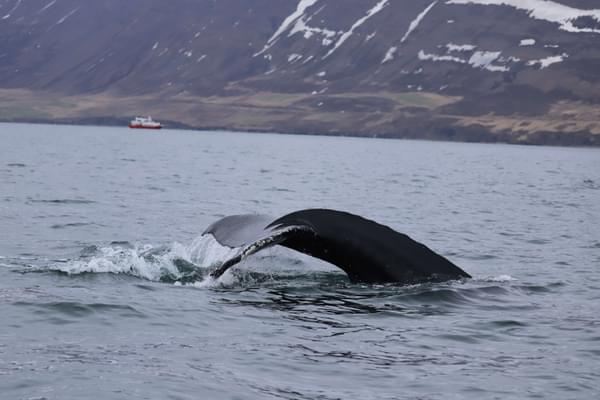
ORCA's work to protect whales and dolphins has never been more important and to help safeguard these amazing animals for the future we need your help. Please support our work by donating at www.orca.org.uk/donate to help us create oceans alive with whales and dolphins

